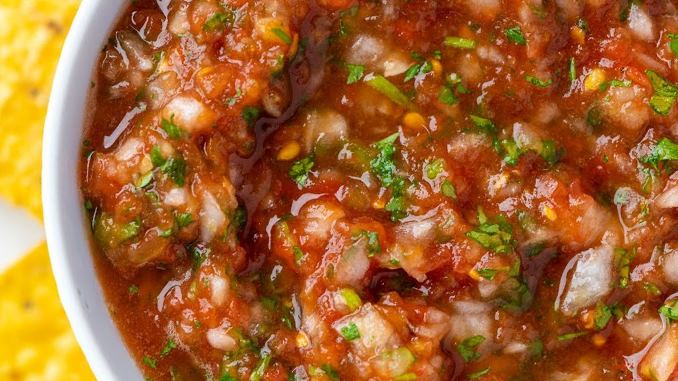Authentic Mexican tortilla chips are not complete without a sauce on the side. Both salsa and pico de gallo are common dips for this lip-smacking snack, and since they look pretty much the same, many people are baffled between the two. Here’s how to tell the differences between these two.
Quick Facts
Salsa
- Freshness: Cooked or uncooked
- Texture: Smooth and soupy with more liquid
- Varieties: Various types
Pico de gallo
- Freshness: Always uncooked
- Texture: Chunky with less liquid
- Varieties: A few
Related: Popular Mexican dishes everyone should know about
The Similarities
While salsas have various forms and interpretations, the most common recipes call for tomatoes, onions, peppers, cilantro, and some lime juice to liven up the taste. These ingredients are also used in pico de gallo recipes.
Though their tastes and textures will be different, you can use these 2 interchangeably to serve with chips. Indeed, they can transform crunchy tortilla chips into juicy, irresistible flavors while working as a dip for meat, fish, or other foods just as well.
In addition, both sauces might contain peppers so that they can be spicy. You can either adjust the spiciness by choosing from different types of peppers or deciding whether to omit the seeds or not.
Also, it does not matter if you want to skip peppers in your recipe; yet, the touch of bell peppers can significantly spice up the flavor.
The Differences
Freshness
Pico de gallo contains a handful of raw ingredients: chopped tomatoes, cilantro, onion, serrano peppers, and a squeeze of lime juice. The freshness of garden produce is a signature of this sauce. The fresh ingredients are a great way to balance the meaty and hearty flavors usually associated with Mexican-inspired dishes.
Salsa can be either cooked or uncooked mixtures. There are also canned supermarket versions that are cooked and sometimes pasteurized to maximize their shelf life. Interestingly enough, the canned or jarred salsas you get from the store are usually pico de gallo but cooked over low heat to extend the shelf life.
Therefore, freshness is the line separating these two sauces.
Texture
Pico de gallo has just a tiny amount of liquid at the base of the bowl, usually from the chopped tomatoes and the lime juice. It also has a chunky texture as the ingredients are typically chopped or diced into bite-size pieces instead of being blended or cooked.
In contrast, salsas are smooth and soupy because the ingredients are often blended or crushed to the desired consistency. They are also more watery when enjoyed.
Varieties
Salsa means simply “sauce” in Spanish – an umbrella term for a variety of hot sauces. It means that there is a whole world of options that you can choose from to serve with chips, tacos, or burritos.
Here are some common types of salsa:
- Salsa Roja: A spicy red sauce with red tomatoes as the base and onion, garlic, cilantro for a well-balanced taste.
- Salsa Verde: The word itself means green sauce. It is a tart and slightly spicy salsa which acts as a base for an endless list of Mexican entrees.
- Salsa Taqueria: This version is known as taco sauce and served at taco stands throughout Mexico. Its spicy nature is an excellent match with the food.
- Salsa Criolla: This is found in Latin American cuisine and consists of finely sliced onions, bell peppers, tomatoes, cilantro, etc.
- Salsa de Aguacate: Smooth, spicy, and creamy! It primarily contains pureed tomatillos and avocado, which give it another name – “avocado sauce.”
In addition to numerous interpretations for the term “salsa,” there are even regional variations within a specific type.
On the other hand, pico de gallo is also a type of salsa, but the ingredients are unlikely to vary from recipe to recipe. While serrano pepper is the most common pepper used for this sauce, some regions use jalapeños or habaneros as an alternative, leading to some differences in taste and flavor.
Can Vegans Have Tortilla Chips And Salsa?
Most jarred store-bought salsas mainly contain tomatoes, peppers, onions, and seasonings, making them healthy condiments for vegans. Meanwhile, tortilla chips do not use animal products most of the time, so that vegans can enjoy an ideal combination of tortilla chips and salsa.
Is Pico De Gallo Healthy?
Yes, it is super healthy. First, it’s low in calories since a large serving contains no more than 20 calories, which assists you in losing weight. In addition, since its main ingredients are primarily veggies, you’ll benefit from numerous nutrients such as vitamin C and A.
There are some widely recognized health benefits you can enjoy from this crisp and colorful salsa. For example, it helps reduce the risk of heart disease and provides antioxidants. Also, the onions in the sauce, according to Healthline, can improve your artery health and prevent atherosclerosis.
How Long Can Salsa Be Left Out Of The Fridge?
Salsa has a shorter lifespan out of the fridge than ketchup or mustard. It is typically safe to eat for 2 hours outside the fridge until the bacteria multiply and increase the risk of you getting ill after consuming the sauce. The best practice is to wait until the last minute to take the sauce out from the fridge and serve it at once.

